Prognathism
Prognathism in vertebrates refers to the shape of the dentition in which the dental arches of the upper and lower jaws protrude significantly from the facial surface, forming what is known as a snout.
In the course of the phylogeny of man, the original prognathism of the early hominini was gradually reduced. The originally parallel left and right rows of molars became increasingly rounded, and the canines also became smaller. The dentition of modern humans is therefore parabolic in shape and hardly protrudes from the facial surface.
In orthodontics, prognathism refers to a position of the upper jaw that is considered undesirable, in which the upper incisors are so far forward or the lower incisors so far back that the upper and lower incisors do not form a scissor bite. A corresponding malocclusion occurs with a shortened lower jaw (mandibular retrognathia).
A bite position in which a comparatively long lower jaw protrudes over a shorter upper jaw is called mandibular prognathism (progenia). Here, the chin and lower lip protrude. The malocclusion, in which the tooth surfaces of the upper and lower teeth do not engage harmoniously with each other, but are often edge to edge or shift each other as a result of incorrect pressure loading, can cause damage to the teeth and the periodontium.
Insects are called prognathous when the head is oriented in the direction of the body axis and the mouthparts point forward accordingly.
· 
Skull of a dog with healthy scissor bite
· 
Skull of a dog with prebite of the lower incisors
· 
Charles II of Spain in a contemporary depiction by Claudio Coello (1642-1693)
· 
slight prognathism in Homo erectus
· 
View to the sagittal plane: above human skull without prognathism, below with prognathic mandible
Questions and Answers
Q: What is Prognathism?
A: Prognathism is a condition where part or all of the face protrudes outwardly more than normal.
Q: What is the shape of human faces?
A: Human faces are orthognathic, which means they are relatively more vertical.
Q: What is the usual shape of primate faces?
A: Most primates have prognathic faces where their jaws protrude out in front of the top part of the head.
Q: Do humans have a prognathic or orthognathic face?
A: Humans have an orthognathic face.
Q: Why do most primates have prognathic faces?
A: Most primates have prognathic faces as a result of their evolutionary adaptation for better survival in their environment.
Q: Is Prognathism a common condition among humans?
A: Prognathism is not a common condition among humans, but it can affect some individuals due to genetic and developmental factors.
Q: Can Prognathism affect a person's ability to eat or speak?
A: Yes, Prognathism can impact a person's ability to eat or speak if the extent of the condition is severe enough to interfere with the function of the mouth and jaw.
Search within the encyclopedia